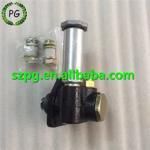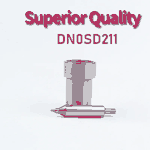Information injection-pump assembly
ZEXEL
101471-0110
1014710110
ISUZU
5156003152
5156003152
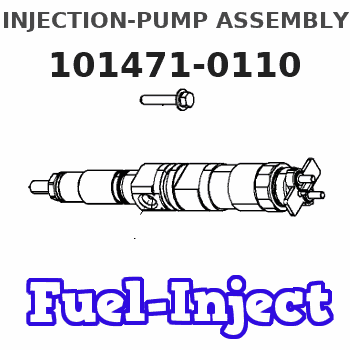
Rating:
Service parts 101471-0110 INJECTION-PUMP ASSEMBLY:
1.
_
6.
COUPLING PLATE
7.
COUPLING PLATE
8.
_
9.
_
11.
Nozzle and Holder
5-15300-024-1
12.
Open Pre:MPa(Kqf/cm2)
11.8{120}
15.
NOZZLE SET
Cross reference number
ZEXEL
101471-0110
1014710110
ISUZU
5156003152
5156003152
Zexel num
Bosch num
Firm num
Name
101471-0110
5156003152 ISUZU
INJECTION-PUMP ASSEMBLY
C330 * K
C330 * K
Calibration Data:
Adjustment conditions
Test oil
1404 Test oil ISO4113 or {SAEJ967d}
1404 Test oil ISO4113 or {SAEJ967d}
Test oil temperature
degC
40
40
45
Nozzle
105000-1650
Bosch type code
DN0SD2110
Nozzle holder
105091-1090
Opening pressure
MPa
17.2
Opening pressure
kgf/cm2
175
Injection pipe
Outer diameter - inner diameter - length (mm) mm 6-2-600
Outer diameter - inner diameter - length (mm) mm 6-2-600
Overflow valve
132424-0620
Overflow valve opening pressure
kPa
157
123
191
Overflow valve opening pressure
kgf/cm2
1.6
1.25
1.95
Tester oil delivery pressure
kPa
157
157
157
Tester oil delivery pressure
kgf/cm2
1.6
1.6
1.6
Direction of rotation (viewed from drive side)
Right R
Right R
Injection timing adjustment
Direction of rotation (viewed from drive side)
Right R
Right R
Injection order
1-3-4-2
Pre-stroke
mm
2.2
2.15
2.25
Beginning of injection position
Drive side NO.1
Drive side NO.1
Difference between angles 1
Cal 1-3 deg. 90 89.5 90.5
Cal 1-3 deg. 90 89.5 90.5
Difference between angles 2
Cal 1-4 deg. 180 179.5 180.5
Cal 1-4 deg. 180 179.5 180.5
Difference between angles 3
Cyl.1-2 deg. 270 269.5 270.5
Cyl.1-2 deg. 270 269.5 270.5
Injection quantity adjustment
Adjusting point
A
Rack position
11.4
Pump speed
r/min
1300
1300
1300
Average injection quantity
mm3/st.
60.8
59.8
61.8
Max. variation between cylinders
%
0
-2.5
2.5
Basic
*
Fixing the rack
*
Injection quantity adjustment_02
Adjusting point
B
Rack position
12
Pump speed
r/min
850
850
850
Average injection quantity
mm3/st.
61.2
58.7
63.7
Max. variation between cylinders
%
0
-4
4
Fixing the lever
*
Injection quantity adjustment_03
Adjusting point
C
Rack position
8+-0.5
Pump speed
r/min
250
250
250
Average injection quantity
mm3/st.
8.5
7.5
9.5
Max. variation between cylinders
%
0
-14
14
Fixing the rack
*
Injection quantity adjustment_04
Adjusting point
D
Rack position
-
Pump speed
r/min
150
150
150
Average injection quantity
mm3/st.
95
95
Fixing the lever
*
Remarks
Excess fuel for starting.
Excess fuel for starting.
Timer adjustment
Pump speed
r/min
500+-50
Advance angle
deg.
0
0
0
Remarks
Start
Start
Timer adjustment_02
Pump speed
r/min
700
Advance angle
deg.
0.7
0.2
1.2
Timer adjustment_03
Pump speed
r/min
1100
Advance angle
deg.
1.9
1.1
2.6
Timer adjustment_04
Pump speed
r/min
1500
Advance angle
deg.
3.9
3.4
4.4
Timer adjustment_05
Pump speed
r/min
1750
Advance angle
deg.
6
5.2
6.2
Remarks
Finish
Finish
Test data Ex:
Governor adjustment
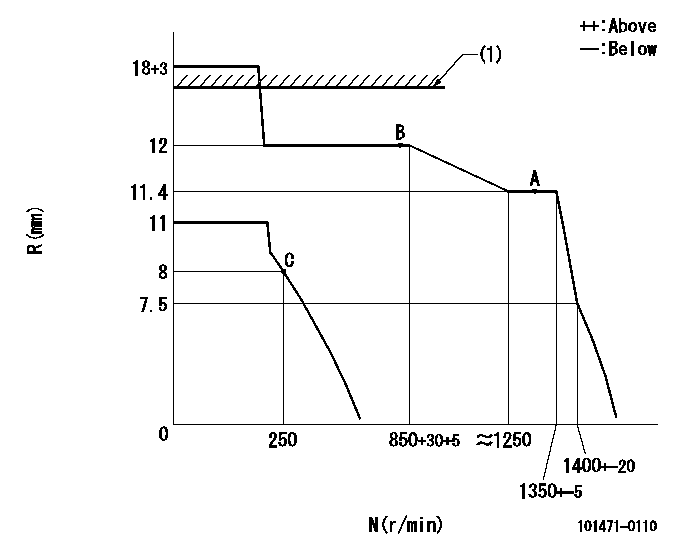
N:Pump speed
R:Rack position (mm)
(1)At rack cap installation: R1
----------
R1=(17.5)mm
----------
----------
R1=(17.5)mm
----------
Speed control lever angle
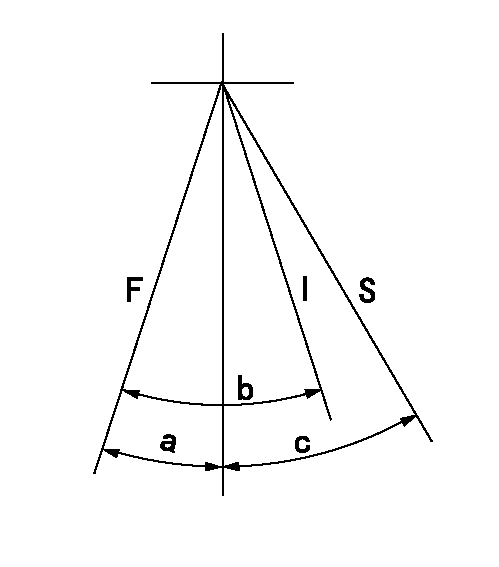
F:Full speed
I:Idle
S:Stop
----------
----------
a=18.5deg+-5deg b=32.5deg+-5deg c=32deg+-3deg
----------
----------
a=18.5deg+-5deg b=32.5deg+-5deg c=32deg+-3deg
Information:
Table 4
Ethylene Glycol Concentration
Concentration Freeze Protection Boil Protection(1)
20 Percent −8° C (18° F) 102° C (216° F)
50 Percent −37 °C (−34 °F) 106 °C (223 °F)
60 Percent −52 °C (−62 °F) 111 °C (232 °F)
(1) Boiling protection is increased with the use of a pressurized radiator.Do not use propylene glycol in concentrations that exceed 50 percent glycol because of the reduced heat transfer capability. Use ethylene glycol in conditions that require additional protection against boiling or freezing. Do not use ethylene glycol in concentrations that exceed 60 percent glycol.
Table 5
Propylene Glycol Concentration
Concentration Freeze Protection Boil Protection(1)
50 Percent −32 °C (−26 °F) 106 °C (223 °F)
(1) Boiling protection is increased with the use of a pressurized radiator.Propylene glycol coolant that is used in the cooling systems for Cat diesel engines must meet ASTM D6210-06, "Fully-Formulated Glycol-Based Engine Coolant for Heavy-Duty Engines". When propylene glycol coolant is used in heavy-duty diesel engines, a regular addition of SCA is required for protection against liner cavitation. Consult your Cat dealer for additional information.Ethylene or propylene glycols used in cooling systems for Cat diesel engines must meet ASTM E1177-06, "Standard Specification for Engine Coolant Grade Glycol".Testing the Concentration of Glycol
To check the concentration of glycol, use the 245-5829 Coolant/Battery Tester/Refractometer or 360-0774 refractometer. The tester can be used with ethylene or propylene glycol.
Illustration 1 g01189253
Approximate curve of the freezing point for a typical ethylene glycol solution.
Table 6
Freeze Protection for Antifreeze Concentrations(1)
Protection to: Concentration
−8° C (18° F) 20% glycol
80% water
−15 °C (5 °F) 30% glycol
70% water
−24 °C (−12 °F) 40% glycol
60% water
−37 °C (−34 °F) 50% glycol
50% water
−52 °C (−62 °F) 60% glycol
40% water
(1) Ethylene glycol-based antifreeze.Alternative products that are used to protect from boiling or freezing of the engine coolant include:
“1,3 propandiol” (PDO)
glycerin
mixtures of these alternative products with glycolAt the time of publication of this document, there currently exists no ASTM, "specifications" for coolants using these chemicals. Until specifications are published and then evaluated by Cat, use of PDO and glycerin or glycerin/glycol coolants are not recommended in Cat cooling systems.Embitterment
Ethylene glycol is a toxic chemical with a naturally sweet taste. In order to avoid accidental excessive ingestion by humans or animals, coolants may contain embittering agents that make the coolant taste bad. All Cat glycol containing coolants (Cat ELC, Cat DEAC, and Cat NGEC) are embittered. Embittering agents have no beneficial or detrimental effect on coolant performance or characteristics.Coolant Terminology
Extended Life Coolant (ELC) - A coolant that relies largely on organic inhibitors for corrosion and cavitation protection. Carboxylate is an example of organic corrosion and cavitation inhibitors. Cat ELC and Cat ELI in water are extended life coolants that also include nitrites and molybdates for increased cavitation protection.
Commercial extended life coolants containing silicate do not meet the additional requirements set in this Special Publication for coolants claiming to meet Cat EC-1 specification.
Do not use commercial extended life coolants with more than 125 ppm silicon (present in the coolant in the form of silicate)
Extended life coolants that meet
Have questions with 101471-0110?
Group cross 101471-0110 ZEXEL
Isuzu
101471-0110
5156003152
INJECTION-PUMP ASSEMBLY
C330
C330
